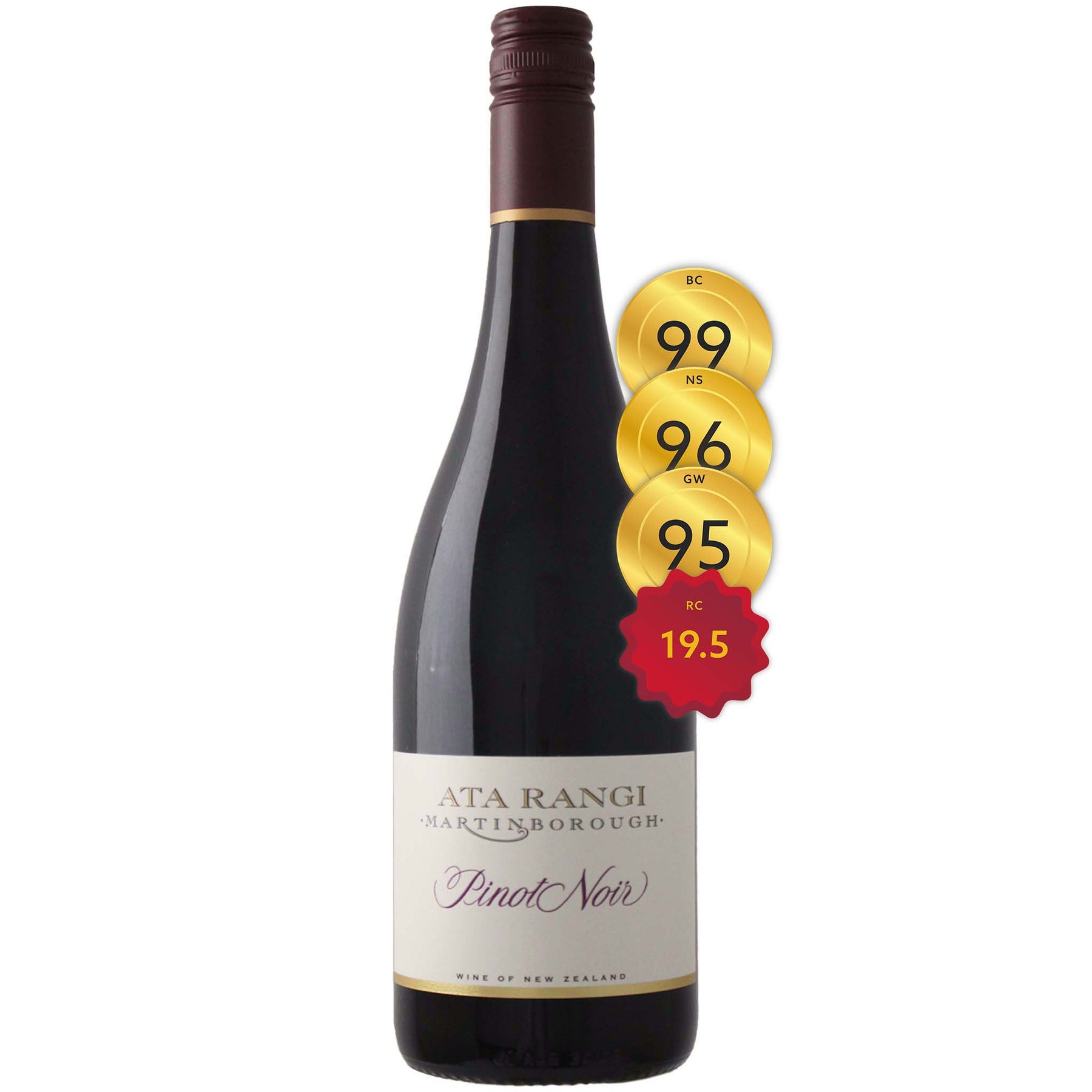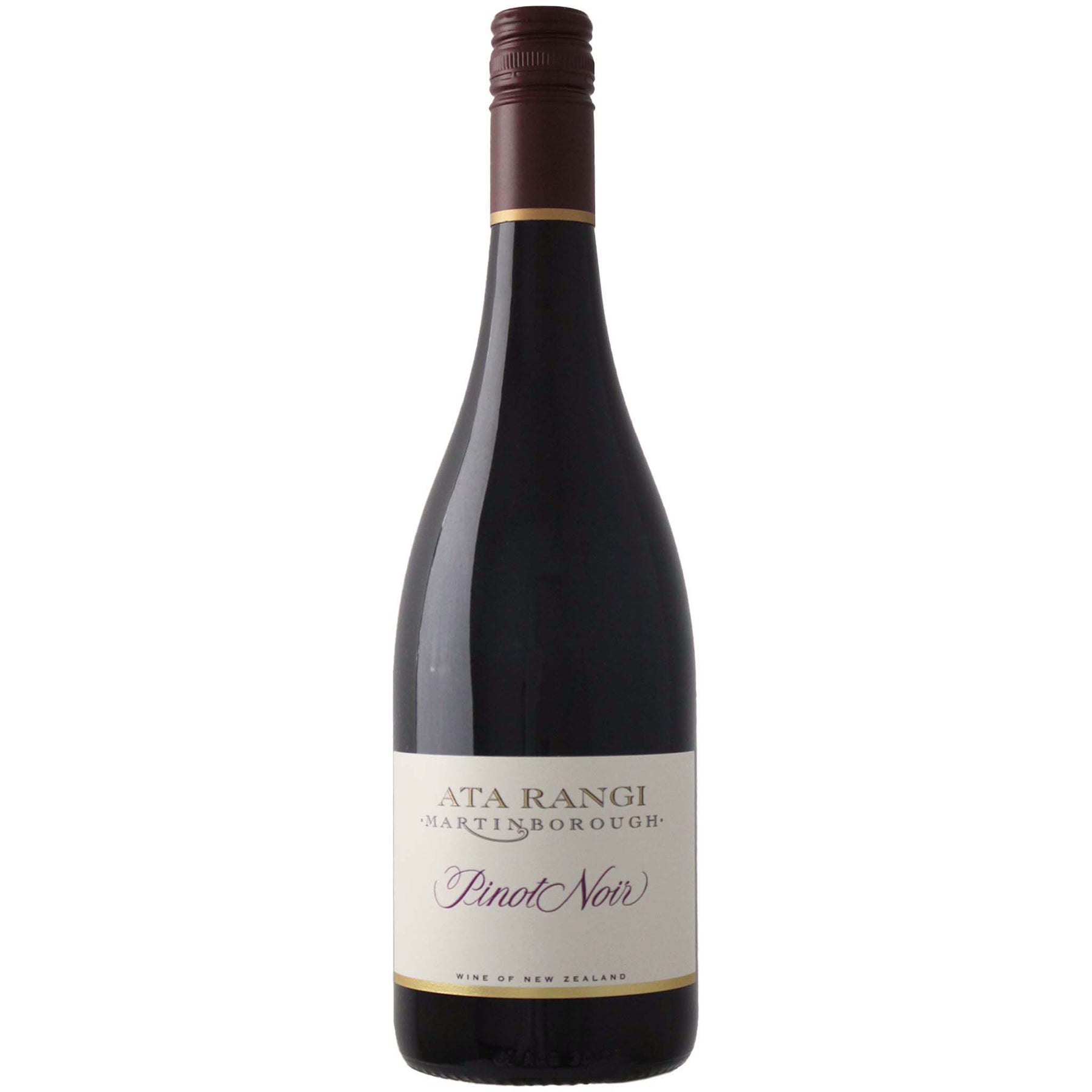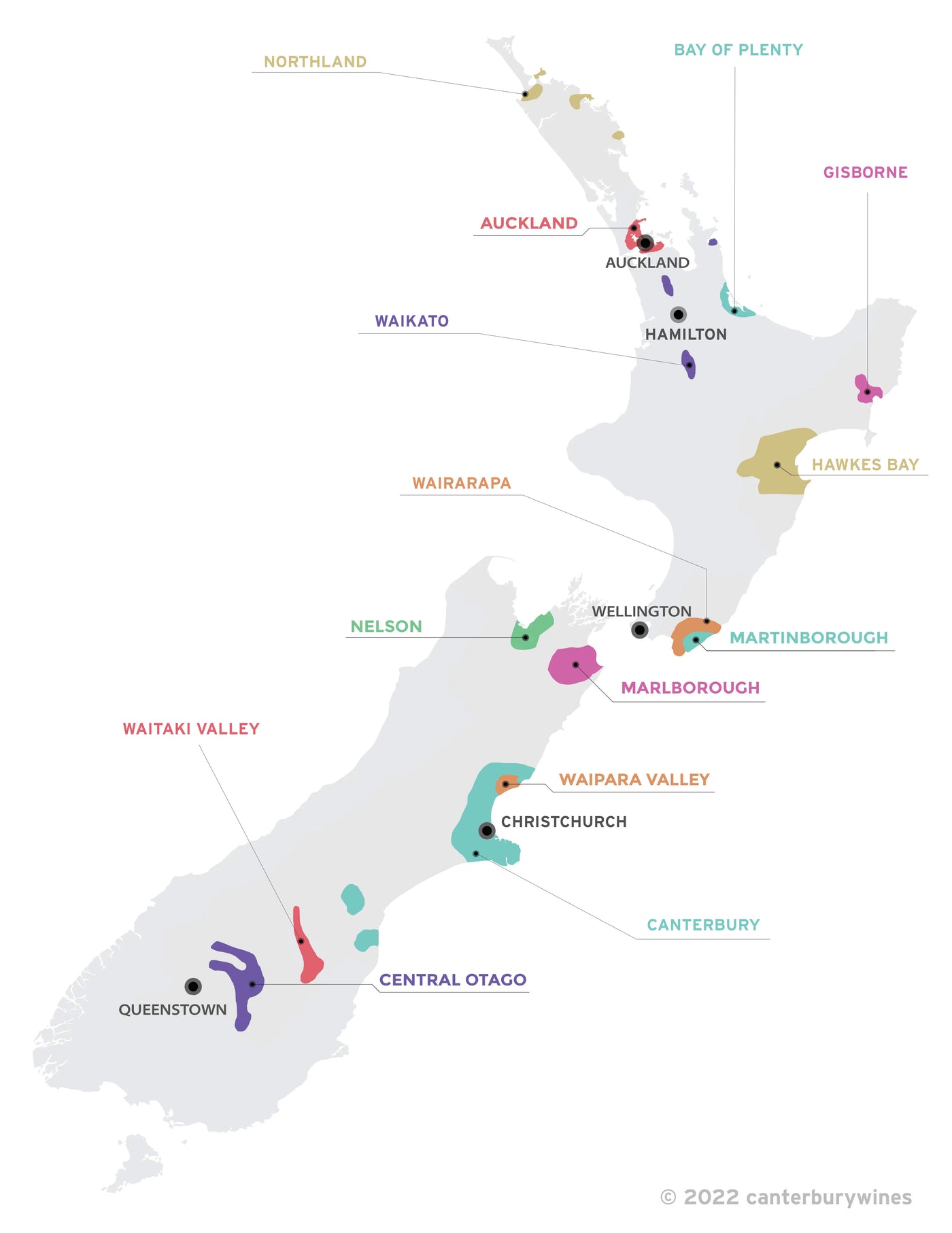

Ata Rangi Pinot Noir 2014
Style: Red Wine
Closure: Screwcap
Ata Rangi Pinot Noir 2014
Warehouse
34 Redland Drive
Vermont VIC 3133
Australia
Critic Score: 99 and 19.5/20
Alcohol: 14.0%
Size: 750 ml
Drink by: 2030
Ata Rangi, meaning 'dawn sky' or 'new beginning', is a small, family-owned, organic winery in Martinborough that has a reputation for producing exceptional quality pinot noir. The Ata Rangi Pinot Noir is their flagship wine and is regarded by many to be one of the greatest pinot noirs that comes out of New Zealand.
"This is a beautifully rich and succulent, elegantly balanced and refined Pinot Noir with seamless-flowing, ripe flavours of dark berry and cherry fruit." Raymond Chan
Expert reviews
"Dense, complex pinot noir in a typical Ata Rangi style, with a nice mix of fruit and savoury characters. Dark-fleshed plum, black cherry with a suggestion of floral, mixed spice and sweet herbs. Spectacular wine with plenty of power and an incredibly lengthy finish. More accessible than the previous vintage was at this stage but showing great cellaring potential. The best Ata Rangi pinot noir I've tasted." Bob Campbell MW, The Real Review - 99 points
"Ata Rangi 2014 earned a record 99 points from me. I seriously considered awarding 100 points and feel the wine will certainly deserve a maximum score after a bit of bottle age." Bob Campbell MW
"Full, even, black-hued ruby-red with youthful purple tints. The nose is very full with softly concentrated and layered aromas of rich, ripe, dark red berries and cherries along with nuances of dark red plums entwined with fragrant violet florals, fresh herb and spicy detail. The aromatics blossom to reveal notes of raspberry liqueur, earth and minerals. This exudes richness allied to elegance and finesse. Medium-full bodied, vibrantly succulent and lusciously sweet fruit flavours of dark red berry and cherry fruit are harmoniously melded with flavours of ripe dark plums and fragrant violet florals, dark herbs, spices and red liquorice. The flavours are seamlessly mouthfilling and supported by refined, flowery tannin extraction, and enlivened by poised acidity. This has drive, energy and fine linearity, and the wine carries to a very long and sustained, rich finish of spiced cherries and raspberry liqueur. This is a beautifully rich and succulent, elegantly balanced and refined Pinot Noir with seamless-flowing, ripe flavours of dark berry and cherry fruit with complexing floral and herbal detail." Raymond Chan – 19.5/20 points ★★★★★
"As ever this has an extra dimension and remains the high watermark for New Zealand pinot noir to be measured against. How do they do it: complete and uncompromised dedication to the cause, combined with an early play to make the most of the available land in a young region, as well as the ability to attract talented and dedicated people such as winemaker Helen Masters to the cause. Already entrancingly complex, the wine has a brambly array of cherry and summer berry fruits in addition to blueberries, some spicy saffron and earthy nuances. It's totally composed and still able to deliver a sense of aromatic purity amid web-like complexity. As you swoon into the first mouthful, it takes total control and is plush and layered with an air of playful luxury. The center billows soft and deceptively airy, finishing in a run of succulent, fresh and satisfying tannins that leave you breathless. Drink now to 2025+." Nick Stock, JamesSuckling.com - 96 points
"Ata Rangi smells like Ata Rangi first and Martinborough second, and while obviously both are true, this vintage seems to deliver the full character of the vineyard. Am I right, or am I right? Typical perfume of roses and potpourri, cherries black and red, spice and a chocolaty flavour in the mix laying on a bit more seduction, in case there wasn't quite enough. Medium bodied, layers of silk and sap, mouth-perfume of roses and dried herbs, fine acidity and excellent length. Closes with a sappy/chicory bitterness that may polarise, but those who like a firm NZ tweak on the finish will take it with pinch of pleasure. Strong release from this great producer." Gary Walsh, The Wine Front - 95 points
About martinborough
 Martinborough is one of the three sub-regions of the Wairarapa wine region in the southern part of New Zealand's North Island. It is world renowned and by far the most important sub-region (the other two being Gadstone and Masterton), so is considered here to be a region to avoid confusion.
Martinborough is one of the three sub-regions of the Wairarapa wine region in the southern part of New Zealand's North Island. It is world renowned and by far the most important sub-region (the other two being Gadstone and Masterton), so is considered here to be a region to avoid confusion.
The small, picturesque town of Martinborough and its surrounding district are home to some of New Zealand's most highly respected boutique wineries. Martinborough lies in a wide river valley between the Rimutaka mountain range and the eastern Wairarapa hills. The Ruamahanga River meanders through the region on its way to Palliser Bay, 32 kilometers to the south. The first vines were planted here by James Busby in 1838 when he was sent from England to collect samples of all grape varieties for potential introduction into Australia (he found that European vines did not grow well in Australia, but thrived in New Zealand's climate conditions). However, it was not until the 1970s that it was discovered as a prime site for viticulture. In 1978, a scientific report compared the climate of the region with that of Burgundy in France, and a few pioneering vignerons began to buy land around Martinborough and plant it with vines.
The viticultural focal point of the region is the Martinborough Terrace – a raised plateau of alluvial gravel just north of the town that has been forced up over time by tectonic movement. The free-draining nature of this soil is excellent for viticulture because it limits the hydration of the vines, leading to stress. These stressed vines put their energy more into producing small, concentrated berries than leafy foliage, increasing the quality of the grapes and subsequently the wines. Similar soils extend around this small area, notably further east, in the unoffical Te Muna sub-region. Vineyards can also be found further south of Martinborough although this region tends to be cooler with a more mixed soil makeup, often with slightly higher levels of clay.
Despite the fact that Martinborough has only three percent of all of New Zealand's vineyard land, it is still widely considered to be one of the country's prime wine regions. Its claim to fame is the exceptional quality of its Pinot Noir wines, produced by some of the most highly regarded wineries in New Zealand.
"Martinborough's reputation for producing high quality pinot has been known for almost as long as the region's existence, but it's a reputation that has seen extraordinary growth in recent times. 'When I came here in 1986 there were only four wine producers,' says McKenna, who to many is recognised as one of the region's father figures. 'Three of them are amongst the best that are still here', referring to Martinborough Vineyard, Ata Rangi and Dry River. 'It's fair to say,' he continues, 'that the combination of vine age and producers' experience with the district has certainly equated to a gradual increase in quality.' The pursuit of excellence is always top of mind, to which Ata Rangi winemaker Helen Masters attests. 'If I need something done, there's no question about cost, time, effort,' she says. 'We just make it happen.' The irony, as any visitor to the region is bound to hear, is that Martinborough contributes just one per cent of New Zealand's annual grape crush but is home to 10 per cent of the country's winemakers. If that's not saying something about the quality of the wine, what is?
The wines here are centred on a few key varieties, but unlike many other regions, are almost impossible to pigeonhole. Everything from the flat, free-draining gravel vineyards of the Martinborough terrace to the denser stony clay soils of Te Muna Road, the heavy focus on terroir, or vintage, or clonal selection, or all of the above, result in a wealth of wine styles that share the common ground of elegance and richness and speak loudly of time and place.
Pinot noir is by far the region's hero – which typically, thanks to the region's climatic similarities to Burgundy, produces beautiful medium-bodied wines with dark plum fruit flavours and distinct savoury characters – followed closely by luscious pinot gris and mineral-like sauvignon blanc, as well as chardonnay, riesling, gewürztraminer and syrah.
The township was established in the late 1870s by John Martin, an Irish landowner whose patriotism for home remains evident in the Union Jack-shaped town square. However, the region's modern wine industry wasn't established until a century later after soil scientist Dr Derek Milne conducted a report that yielded the resemblance-to-Burgundy results. He subsequently founded Martinborough Vineyard; others soon followed suit and those four or five founding producers spawned a progressive farming community that lives and breathes the 'wine is made in the vineyard' philosophy. It's a special place." Dom Sweeney, Gourmet Traveller Wine
About the winery

Ata Rangi, meaning 'dawn sky' or 'new beginning', is a small, family-owned, organic winery in Martinborough that has a reputation for producing exceptional quality pinot noir. Ata Rangi was founded by Clive Paton in 1980. The first vines were planted on a small, stony sheep paddock at the edge of the Martinborough Village. Clive's sister Alison bought an adjoining block soon after and in 1986 Clive's partner Phyll Pattie bought a share in the business after moving from Marlborough where she had been working as a winemaker.
Today, 42 years on, Ata Rangi has an enviable reputation as one of the new world's most respected pinot noir producers. Alison Paton heads up the day-to-day running of the business, with Helen Masters crafting the wines aided by the vital stewardship of vineyard manager Braden Crosby.
Ata Rangi farms around 32 hectares, spread over 14 vineyards, that are clustered around the village of Martinborough. The sites feature the characteristic Martinborough Terrace profile of 300-600mm of shallow silt-loam overlaying 25-30 metre-deep alluvial gravels. The McCrone and Masters Vineyards are differentiated by a higher percentage of clay within the gravels.
Ata Rangi's home vineyards attained full organic status in 2014. Weeds are managed with under-vine weeding tools, with a combination of cultivation and mowing. The vineyards' biodiversity is enhanced by a mixture of native and exotic shelterbelts and inter-row wildflower planting that provide havens for native predatory and beneficial insects. Compost is made on-site from grape stalks, skins, and yeast lees, mixed with seaweed, forest floor duff and harvested green crops. This mix is utilised in the vineyard to make compost tea for vine health and boost organic matter within the soil.
Fruit is drawn from a diverse range of vineyards, each managed to suit its soil and clonal diversity. This individualised care, alongside the age of the original vines which are now reaching 40 years old, are both major factors in the quality and consistency of the wines from year to year. Spring is often cool and windy which reduces fruit set, so yields are naturally low. Summer days are consistently warm, though nights are generally cool. Autumn is often long and dry, perfect for hand harvesting.
The Ata Rangi winemaking philosophy is a simple, hands-off, traditional approach focused on finding the true expression of the place. They see wines from Martinborough as having a real depth of palate with texture and length. They aim for balance in all their wines, so use winemaking practices such as whole bunch and barrel ageing to ensure that vineyard expression remains the hero.
Each season brings its own unique growing conditions. Cooler vintages express more herbal and spicy notes, whereas a warmer season delivers fuller fruit aromas. Staying true to the vintage means the wines will express these features. They focus on harvesting at the point where ripeness is "optimum” i.e where sugar, tannin and acid intersect at a "just on the cusp of ripeness”, and tension and vibrancy of aroma are balanced with tannins.
Whole bunch inclusion plays a role in the fermentations of the pinot noir — the level of which varies according to site and vine age, which can be from 20 to 100% with the remainder de-stemmed. The fermentation that takes place within the whole berry along with the contact with the stems, lifts the aromas and gives a fine flow to the tannins.
Due to the close proximity to the South Pacific Ocean, the temperate climate results in an extended growing season, allowing the fruit to ripen slowly. This enables the tannins in the seeds and skin of the grapes to fully ripen. This is reflected in the Ata Rangi style, a backbone of fine tannins, supported by vibrant acidity which gives a structure to the wines that afford them real age-ability.

New Zealand
New Zealand is home to more than 700 wineries across 14 wine regions. The regions are Auckland, Bay of Plenty, Canterbury, Central Otago, Gisborne, Hawkes Bay, Marlborough, Martinborough*, Nelson, Northland, Waikato, Waipara Valley, Wairarapa and Waitaki Valley. * Martinborough is a sub-region of Wairarapa, however, as it is world renowned it is considered here to be a region to avoid confusion.
The wine regions in New Zealand stretch from latitudes 36°S (Northland) in the north (comparable in latitude to Jerez, Spain), to 45°S (Central Otago) in the south (comparable in latitude to Bordeaux, France). New Zealand's climate is maritime, producing cooler summers and milder winters than would be expected at similar latitudes in Europe.
Viticulture in New Zealand dates back to 1836 when British resident James Busby produced wine in the far north, but it wasn't until 1985 that the wine industry came of age when Cloudy Bay Sauvignon Blanc garnered international attention and critical acclaim.
New Zealand is internationally renowned for Sauvignon Blanc (particularly from Marlborough), Pinot Noir (Central Otago, Martinborough and Waipara Valley), Chardonnay, Bordeaux-style blends of mainly Merlot and Cabernet Sauvignon (Hawkes Bay) and Syrah (Hawkes Bay). Sauvignon Blanc accounts for 63% of the area of the national vineyard, followed by Pinot Noir (14%), Chardonnay (8%), Pinot Gris (7%) and Merlot (3%).

